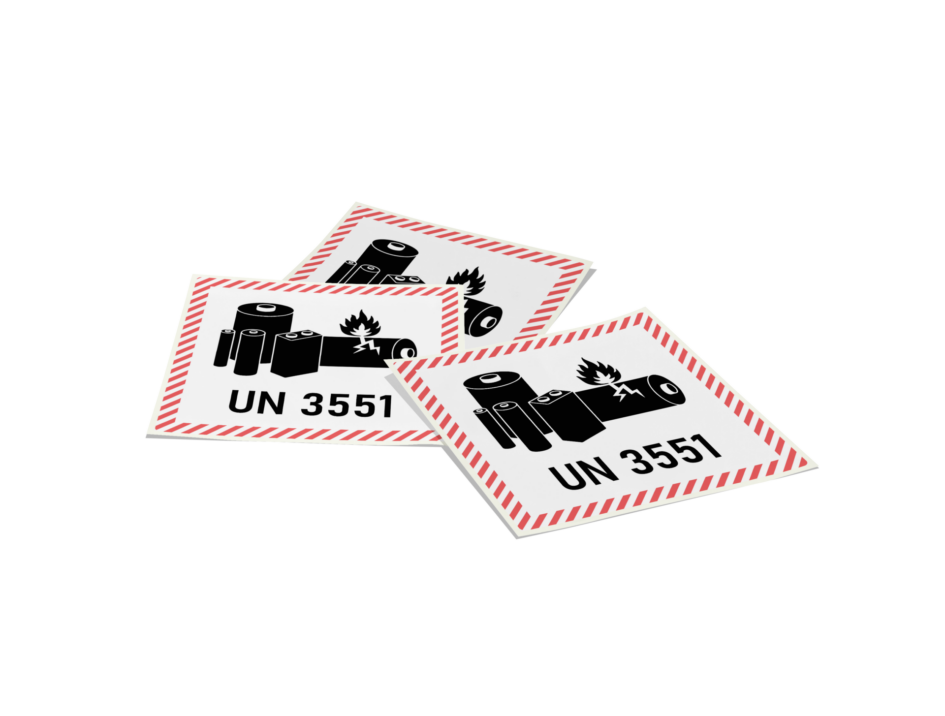Datum:
12. September 2024
Kategorie:
Company, Industry News, Products, Tips & Tricks,
Datum:
12. September 2024
Kategorie:
Company, Industry News, Products, Tips & Tricks,
From 2025, the following new UN numbers will be introduced to regulate the handling of batteries:
This number applies to sodium-ion batteries with organic electrolyte. Sodium-ion batteries are a more cost-effective alternative to lithium-ion batteries and offer improved thermal stability, which makes them safer for transportation. They can also be transported in a deeply discharged state.

Diese Nummer gilt für Natrium-Ionen-Batterien mit organischem Elektrolyten. Natrium-Ionen-Batterien sind eine kostengünstigere Alternative zu Lithium-Ionen-Batterien und bieten eine verbesserte thermische Stabilität, was sie sicherer für den Transport macht. Sie können auch im tiefentladenen Zustand befördert werden.
This number covers sodium-ion batteries in equipment or packed together with equipment. This classification ensures that sodium-ion batteries transported in combination with equipment are also handled correctly.
The previous UN number 3292 will now be renamed “Batteries or cells containing metallic sodium or sodium alloys” in order to create a clear distinction from the new numbers. This also entails new special provisions (SV 400, SV 401, SV 677).
This number is intended for vehicles with lithium-ion batteries. It covers the transportation of vehicles powered by these batteries.
This number applies to vehicles powered by lithium metal batteries.
This number applies to vehicles powered by sodium-ion batteries.
There is also a new special regulation for UN 3558: SV 404 and a new packing instruction P 912.
In addition to the battery-related numbers, there are also new UN numbers for other substances and materials:
The new UN numbers and regulations in ADR 2025 are crucial for the safe and compliant transportation of batteries and other hazardous materials. The introduction of UN 3551 and UN 3552 shows the growing importance of sodium-ion technologies and their specific transportation requirements. The other changes expand the regulations for other hazardous substances and improve safety in the transportation of dangerous goods.
Further details on the changes and their effects can be found in the current publications on dangerous goods legislation.
We are pleased to announce that BOXLAB Services has already responded to the change in the minimum size and layout for the marking of lithium and sodium batteries in ADR 2025. We have added labels in the new format and layout to our range and offer them in various designs. Whether you need single sheets, 500 or 3000 rolls, we have the right quantity for your needs. All our dangerous goods labels are seawater resistant to BS 5609 Section III, which means they will remain durable and highly visible even in harsh environments, including sea transportation.
Do you have questions about the new store, registration, our products or invoicing?
With the introduction of UN numbers 3551 and 3552 in ADR 2025, the transportation of sodium-ion batteries will be more clearly regulated. UN 3551 applies to loose sodium-ion batteries powered by organic electrolytes. These batteries offer a cost-effective alternative to lithium-ion batteries and are characterized by their thermal stability, which makes them safer for transport. UN 3552, on the other hand, concerns sodium-ion batteries that are packed together with equipment. Both numbers ensure that the special requirements and safety precautions for sodium-ion batteries are correctly observed. Find out more about the new regulations and how you can prepare for the changes.
The new UN numbers 3556 and 3557, which will be introduced in ADR 2025, concern vehicles powered by lithium-ion and lithium-metal batteries respectively. UN 3556 covers vehicles equipped with lithium-ion batteries, while UN 3557 applies to vehicles using lithium-metal batteries. These classifications bring with them new requirements and safety regulations to ensure the safe transportation and carriage of these batteries. Find out about the specific regulations and safety measures required for these types of vehicles.
The introduction of UN numbers 3559 and 0514 in ADR 2025 brings new safety standards for fire extinguishing agents specifically designed for lithium battery fires. UN 3559 and UN 0514 refer to fire extinguishing agent dispersing devices that are particularly effective for lithium battery fires. These systems are commonly used in battery storage systems, data centers and as a safety measure in lithium battery packaging. Find out how these new regulations improve safety standards and what criteria apply to the use of these extinguishing agents.